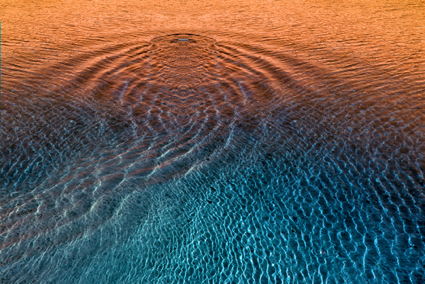
Go With The Flow
Wake I, Acadia National Park, Maine, 2000
One sunny day at Long Pond in Acadia National Park, Maine, I became fascinated by the patterns of light in water I saw in my viewfinder. Suddenly, the patterns were disrupted. I looked up and saw the source of the disturbance. My dogs had gone swimming in my picture. But I soon found that the new patterns they made were much more interesting. I decided to go with the flow. Instead of calling them back to the shore, I threw sticks into the water for them, simultaneously playing and photographing for the better part of an hour.
When I got my film back (Yes, this image was made during the transition from the ‘good old days’ to these ‘strange days’.) I was surprised once again by how complex and varied patterns of light can be. These patterns became more pronounced when symmetry, almost mandala-like, was created. Creating symmetry from these patterns wasn’t a move I had planned to make at the time of exposure. There are many times when I make images when I’m not certain that they will work out or where they are going, trusting that something will come of them. It’s surprising that things work out as often as they do.
The natural color palette of these images wasn’t all that attractive. I first explored removing the hue, trying black and white. Then I changed the hue. I went too far. Or so I thought. The strong abstract patterns were able to support dramatic color changes. I went with the flow, enjoying color in a way I never had before. It took some time to run out of steam. Some flows are stronger than others. Was it gone? Was that it? Where was the limit? I systematically tried many variations. Shifting gears and being more analytic than emotive, through a series of studies, I discovered that the images that worked best contained no posterization, preserving three-dimensionality, and used two dominant colors with warm and cool variations of each, stretched just short of the point where they became other colors. With this information, I was able to resolve many more images. I extended the momentum of the flow.
I was surprised by how much material I had to work with. Initially, I hoped to find one image; now, I found that I had enough material for an entire series. What’s more, the idea could be extended to many other situations in the future; it had legs.
You might say things didn’t go according to plan – and I was very glad they didn’t. It might be more accurate to say that the plan evolved along the way, as the best plans do.
To go with the flow, you have to tune in. You can’t go with the flow if you’re unaware of what’s happening or that it’s happening. Going with the flow is something that you can prepare for. You can learn to be more aware. You can learn to be aware in many ways. You can develop a taste for flow and know when it’s about to happen. You can make flow more likely to happen by seeking out or creating situations that are super-charged. You can engineer flow – by preparing yourself (and your collaborators) as well as your environment. Flow is a mindset.
The Greek philosopher-scientist Heraclitus said, “You can never step in the same river twice.” Seize the moment. Go with the flow.
Questions
What happens when you go with the flow?
What happens when you stay the course?
What happens when you modify a plan based on new information?
When is it better to go with the flow?
When is it better to stay the course?
When is it better to modify a plan based on new information?
Can you return to your original plan later?



No Comments